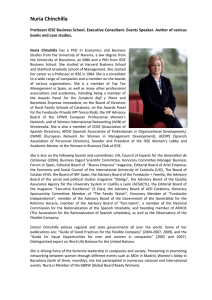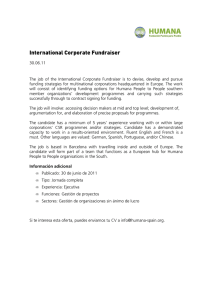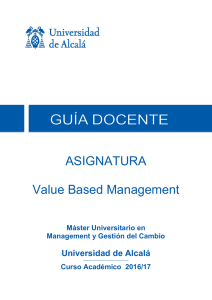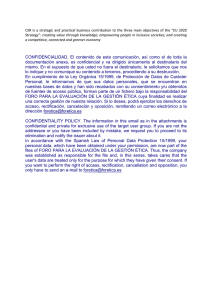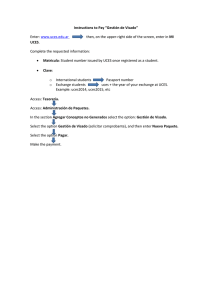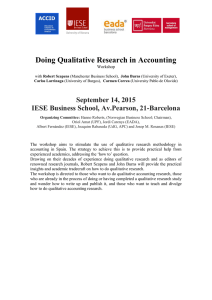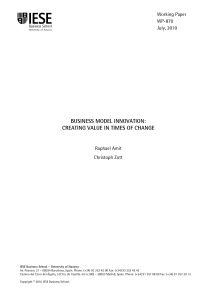marketing, planning and implementation
Anuncio
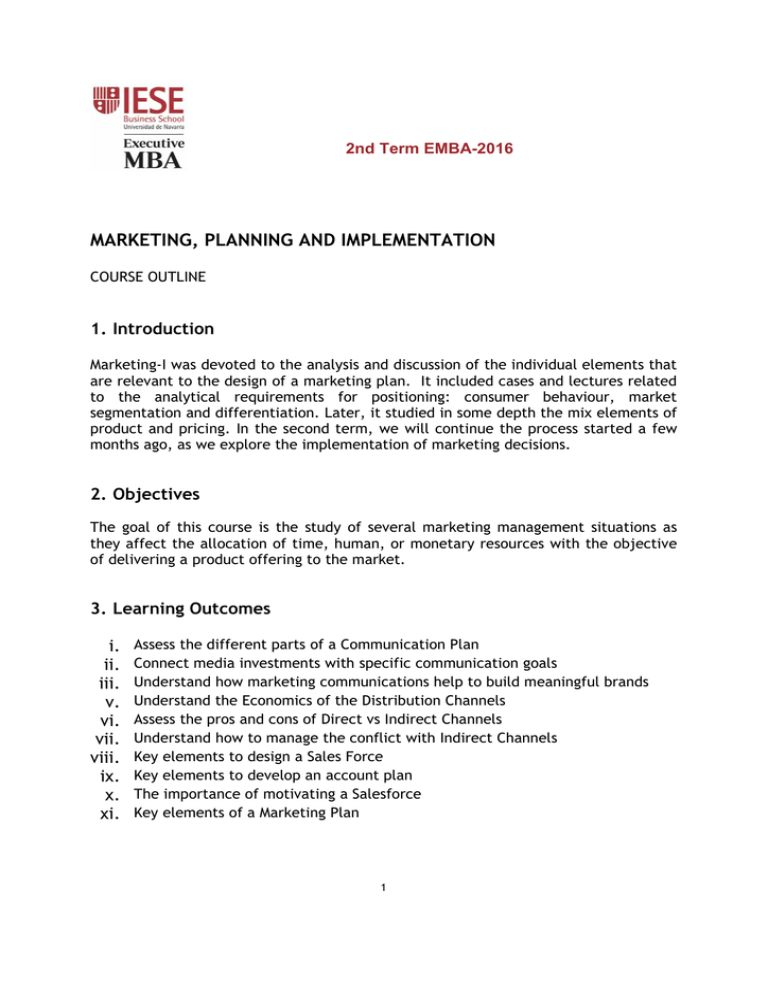
2nd Term EMBA-2016 MARKETING, PLANNING AND IMPLEMENTATION COURSE OUTLINE 1. Introduction Marketing-I was devoted to the analysis and discussion of the individual elements that are relevant to the design of a marketing plan. It included cases and lectures related to the analytical requirements for positioning: consumer behaviour, market segmentation and differentiation. Later, it studied in some depth the mix elements of product and pricing. In the second term, we will continue the process started a few months ago, as we explore the implementation of marketing decisions. 2. Objectives The goal of this course is the study of several marketing management situations as they affect the allocation of time, human, or monetary resources with the objective of delivering a product offering to the market. 3. Learning Outcomes i. ii. iii. v. vi. vii. viii. ix. x. xi. Assess the different parts of a Communication Plan Connect media investments with specific communication goals Understand how marketing communications help to build meaningful brands Understand the Economics of the Distribution Channels Assess the pros and cons of Direct vs Indirect Channels Understand how to manage the conflict with Indirect Channels Key elements to design a Sales Force Key elements to develop an account plan The importance of motivating a Salesforce Key elements of a Marketing Plan 1 IESE Business School Marketing, Planning & Implementation 4. Competences This course builds and reinforces the following competences: CB6 – Students should possess and understand knowledge that provides the basis or opportunity for originality in the development and/or application of ideas, often in a research context. CB7 – Students should know how to apply the knowledge acquired and their problemsolving capacity in new and little-known settings within broader (or multidisciplinary) contexts related to their area of study. CB8 – Students should be able to integrate knowledge and deal with the complexity of making judgements based on information that is incomplete or limited, but includes considerations of the social and ethical responsibilities linked to the application of the students' knowledge and judgements. CB9 – Students should know how to communicate their conclusions and knowledge and the ultimate reasons that support them to specialized and unspecialized audiences in a clear, unambiguous way CG9 - Recognizing the dangers and taking advantage of the opportunities that impact the competitiveness and effectiveness of the business (Business Vision) CG10 - Valuing the company above and beyond the limits of one's own job, understanding the interrelationship between the different units and developing interfunctional cooperation (Vision of the Organization) CG11 - Meeting customers' needs, offering them something of value, taking care of every detail in the relationship and providing a response to their requests and suggestions (Customer Orientation). CG12 - Using material and economic resources in the best, fastest, most economical and effective way possible to obtain the desired results (Resource Management). CE18 - Analyzing markets and new business opportunities. Designing sound, relevant and effective market research studies. Having a deep understanding of segmentation, targeting and positioning concepts and putting them into practice. CE19 - Analyzing consumer behavior using empirical analysis tools and theoretical models of human behavior. CE20 - Learning to develop new products or reposition existing ones by means of product, distribution, pricing and communication policies. Managing brands. 2 IESE Business School Marketing, Planning & Implementation CE21 - Designing marketing strategies that include and take advantage of information systems and new social networks. 5. Content The course is divided into three modules: 1. Management of the sales force. For many companies, sales represent the only source of income. Thus, for companies that decide to market with (at least in part) an organization of direct sales, the management of its sales force and its integration with other distribution channels are important. Here we will discuss the sales process for different types of products, policies and supervision to direct sellers individually and ultimately their sales training. 2. Distribution Channels: Design and Management. In this module we will focus on understanding the main options when it comes to getting the supply to the market. Should the company to deliver products directly to end customers? Should I use one or more of the various intermediaries (eg agents, wholesalers, value-added resellers, etc.)? What is the economy of the different distribution channels and how they affect the final price and the level of service that the product is shipped to the customer? What are the decisions that must be taken to cope with the changing market conditions? Is there is conflict in the channel and if necessary, how it should be handled? 3. Communication Policy. The end of the marketing strategy is to determine (a) To serve customers, (b) which offer present and finally determine (c) how to present the offer. Communication policies determine the best way to get our message to those customers. We discuss the necessary elements to develop this policy: mission, market, message, media, budget and measurement. Cover the more "hard" aspects of communication (eg, measuring the results of a campaign) as the most "soft" (eg, choosing creativity) 6. Methodology The basic methodology of this course is case discussions and lectures. Class participation is the key evaluation source, and you will be required to be very well prepared for the case discussion sessions. Superficial preparation generates non relevant class contributions. Your presence, preparation, and participation are of great importance for the learning experience. Not attending to class is a serious matter and you have to communicate it to the section head as well as to myself. Please, take each session as the last of the whole course, and do not postpone getting feedback if you feel you have trouble contributing to the class. 3 IESE Business School Marketing, Planning & Implementation 7. Evaluation Class participation shall be evaluated on the sound marketing reasoning and understanding of the concepts developed in the course. The evaluation of your performance will be based on your class participation (65%) and final exam (35%) 4 IESE Business School Marketing, Planning & Implementation 8. Course Outline & Bibliography Título Caso Lecturas I. Gestión de la fuerza de ventas 1 Políticas de venta Deodar (M-1209) Dirección de Ventas (*) Material Multimedia, visitar http://blog.iese.edu/ve ntas/ usuario: blogiese contraseña: IESE.2015 2 La motivación de los equipos de venta” I.M.A.G.E International (UVAM-0417). 3 Evaluación y control Anfisa: Alarma en la zona norte (M-1253) 4 La venta de servicios profesionales Hale & Dorr (A) (510S17) 5 El argumentario de ventas y la maldición del emprendedor Polyphonic HMI: Mezclando música y matemáticas (506S18) What entrepeneurs get wrong, HBR 6 Gestión de grandes cuentas Microsoft España: el programa de grandes cuentas (M-1236) Reflexiones sobre la venta a grandes clientes (MN-367) Las funciones del jefe de ventas (MN-168) II. Diseño y gestión de los canales de distribución 7 Diseño del canal Soren Chemical (4188) 5 Distribución (MN-368) (*) IESE Business School Marketing, Planning & Implementation Título Caso 8 Canales de venta indirecta AGEVI 9 Los errores más comunes en la gestión de los equipos comerciales Conferencia coloquio Lecturas III. Comunicación en la era digital 10 Creando marca sin inversión publicitaria elBulli: el Sabor de la Innovación (509S01) Marketing Integrado de Comunicación (504S12) (*) 11 Se anunciará 12 SEO, Display y el “funnel” de comunicación BBVA Compass (511S13) Estrategia y generación de tráfico en la web (MN-373) SEO (MN-374) SEM (MN-376) Campañas de Display (MN-378) 13 ¿Se puede crear marca en las redes sociales? Coca-Cola España: Branding 2.0 (M-1269) Social Media Marketing (MN-381) 14 Estrategia de comunicación Turrón de chocolate Suchard: Hecho con tus sueños 15 Conferencia-Coloquio IV. Sosteniendo el valor a través de la gestión de los clientes 16 Gestionando el valor económico del cliente Harrah’s Entertainment 17 Orientación al cliente Starbucks: Delivering Service Quality (9-503-S69) 6 *La gestión del valor del cliente (MN‐352) IESE Business School Marketing, Planning & Implementation 7
